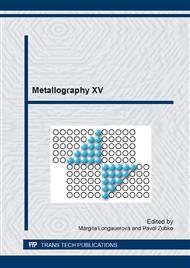p.251
p.257
p.263
p.269
p.275
p.279
p.284
p.288
p.295
Investigations on a Defect Sewer Pipe, Attacked by Microbiologically Produced Acid
Abstract:
A nodular cast iron (German designation GGG) sewer pipe leaked within a short time of use (13 years). The pipe was destroyed by sulphuric acid induced corrosion. Microbes form hydrogen sulphide and further oxidation leads to H2SO4. Sewer pipes are coated inside with a protective alumina cement layer, which was attacked firstly, followed by a corrosion of cast iron. Spongiose is a corrosion of cast iron, thereby ferrite is destroyed and graphite and cementite are remaining unattacked. Spongiose is observed commonly in grey cast iron, but is unusual for nodular cast iron. The alumina cement coated GGG tube, the corrosion products and their different graduations were investigated. In the corroded spongiose-layer the crystalline phases graphite, cementite, hematite and magnetite were identified. In the rust-layer deposits of lepodocrocite and goethite are the main phases but also sulphur, gypsum and other sulphuric compounds were observed.
Info:
Periodical:
Pages:
275-278
Citation:
Online since:
April 2014
Authors:
Keywords:
Price:
Сopyright:
© 2014 Trans Tech Publications Ltd. All Rights Reserved
Share:
Citation:


